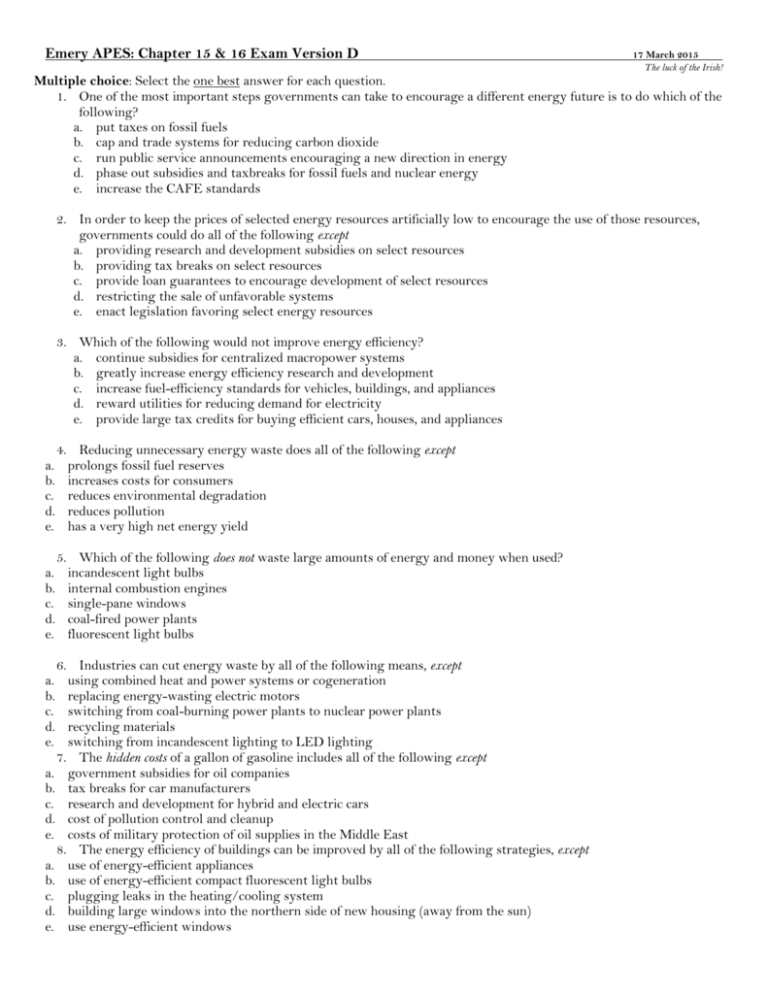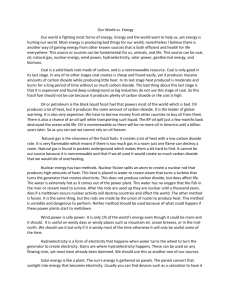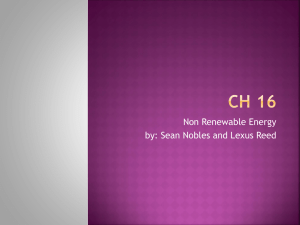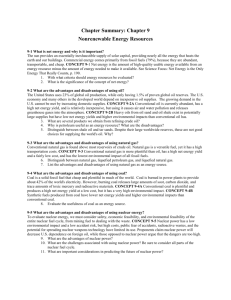Emery APES: Chapter 15 & 16 Exam Version D 17 March 2015 The
advertisement

Emery APES: Chapter 15 & 16 Exam Version D 17 March 2015 The luck of the Irish! Multiple choice: Select the one best answer for each question. 1. One of the most important steps governments can take to encourage a different energy future is to do which of the following? a. put taxes on fossil fuels b. cap and trade systems for reducing carbon dioxide c. run public service announcements encouraging a new direction in energy d. phase out subsidies and taxbreaks for fossil fuels and nuclear energy e. increase the CAFE standards 2. In order to keep the prices of selected energy resources artificially low to encourage the use of those resources, governments could do all of the following except a. providing research and development subsidies on select resources b. providing tax breaks on select resources c. provide loan guarantees to encourage development of select resources d. restricting the sale of unfavorable systems e. enact legislation favoring select energy resources 3. Which of the following would not improve energy efficiency? a. continue subsidies for centralized macropower systems b. greatly increase energy efficiency research and development c. increase fuel-efficiency standards for vehicles, buildings, and appliances d. reward utilities for reducing demand for electricity e. provide large tax credits for buying efficient cars, houses, and appliances a. b. c. d. e. 4. Reducing unnecessary energy waste does all of the following except prolongs fossil fuel reserves increases costs for consumers reduces environmental degradation reduces pollution has a very high net energy yield 5. Which of the following does not waste large amounts of energy and money when used? a. incandescent light bulbs b. internal combustion engines c. single-pane windows d. coal-fired power plants e. fluorescent light bulbs 6. Industries can cut energy waste by all of the following means, except using combined heat and power systems or cogeneration replacing energy-wasting electric motors switching from coal-burning power plants to nuclear power plants recycling materials switching from incandescent lighting to LED lighting 7. The hidden costs of a gallon of gasoline includes all of the following except a. government subsidies for oil companies b. tax breaks for car manufacturers c. research and development for hybrid and electric cars d. cost of pollution control and cleanup e. costs of military protection of oil supplies in the Middle East 8. The energy efficiency of buildings can be improved by all of the following strategies, except a. use of energy-efficient appliances b. use of energy-efficient compact fluorescent light bulbs c. plugging leaks in the heating/cooling system d. building large windows into the northern side of new housing (away from the sun) e. use energy-efficient windows a. b. c. d. e. a. b. c. d. e. a. b. c. d. e. 9. Growing biomass in plantation settings has all of the following disadvantages, except depletion of soil nutrients clearing forests for plantations degrades biodiversity clearing forests for plantations contributes to soil erosion plantation grown biomass is very expensive to burn clearing forests for plantations reduces carbon dioxide capture 10. Which of the following statements about hydrogen is false? no direct carbon dioxide emissions if produced from water good substitute for oil very high net energy yield can be produced from plentiful water at some sites while being expensive, it could potentially be a viable resource with government subsidies. 11. One of the general conclusions of experts about future energy systems is that greatly improved energy efficiency of renewable resources and the temporary use of which of the following nonrenewable resources, is the way we will proceed. a. coal b. fuel oil c. nuclear power d. natural gas e. hydroelectric power 12. Valid reasons that renewable energy resources have not substantially replaced nonrenewable energy resources in the United States include all of the following except a. In general, people tend to avoid change b. Renewable resources tend to be intermittently available depending on the region c. Many Americans do not think switching to more renewable resources is necessary d. The oil and gas industry fights any legislation or subsidies toward researching and implementing renewable resources e. The United States does not have sufficient renewable resources available domestically 13. Which of the following is the biggest disadvantage to using wind power? a. Wind power can be unpredictable and unreliable b. Wind turbines can kill migrating birds c. Wind farms are very expensive to build d. Wind power is nonrenewable e. Possible locations are very rare 14. Cutting down on energy waste has many benefits, yet few people take full advantage of the cost savings. All of the following are reasons why this occurs, except a. the government gives tax breaks and subsidies to keep costs low b. the market price for energy does not include environmental and health costs c. there are very few incentives for consumers to use energy-efficient products d. the government has done a great job encouraging car fuel efficiency e. people tend to resist change even if it saves them money a. b. c. d. e. 15. Which of the following is not a means to cool a building naturally? orient the building to catch the sun a living roof open windows to catch the breeze light-colored roof awnings, window overhangs a. b. c. d. e. 16. Which of the following is not true of heating a house with passive or active solar energy? Net energy is moderate to high very low carbon dioxide emissions very low land disturbance low installation and maintenance costs for active systems moderate cost for passive systems a. b. c. d. e. 17. The advantages of solar cells include all of the following, except moderate net energy yield little or no direct emissions of carbon dioxide electricity storage systems are readily available for nighttime and rainy days easy to install and expand as needed competitive costs for newer cells a. b. c. d. e. 18. The world’s fastest growing way to produce electricity is hydroelectric solar cells geothermal nuclear hydrogen cells a. b. c. d. e. 19. The world’s leading renewable energy source used to produce electricity is hydrogen biomass ethanol hydropower coal a. b. c. d. e. 20. Which of the following is not a means to cool a building naturally? orient the building to catch the sun a living roof open windows to catch the breeze light-colored roof awnings, window overhangs 21. Which one of the following countries is not one of the top five producers of hydropower? (Remember: this is because their natural geography lacks the combination of sufficient rainfall and mountain streams that have few nearby populations of people.) a. Canada b. China c. Brazil d. Germany e. United States a. b. c. d. e. 22. Which of the following is not considered biomass? wood crop residues charcoal animal manure coal a. b. c. d. e. 23. Growing biomass in plantation settings has all of the following disadvantages, except depletion of soil nutrients clearing forests for plantations degrades biodiversity clearing forests for plantations contributes to soil erosion plantation grown biomass is very expensive to burn clearing forests for plantations reduces carbon dioxide capture 24. The United States uses approximately what percentage of all the oil produced in the world? a. 2% b. 6% c. 12% d. 18% e. 23% 25. Which of the following is not a member of OPEC? a. Saudi Arabia b. United States c. Kuwait d. Iran e. Venezuela 26. Which of the following is the primary gas in natural gas? a. ethane b. methane c. propane d. butane e. hydrogen sulfide 27. The total amount of high-quality energy available after the energy needed to make it available is subtracted, is called a. net energy b. total energy c. useful energy d. gross energy e. entropy 28. All of the following are ways the United States unnecessarily wastes energy, except a. driving gas-guzzling vehicles b. getting electricity from inefficient coal-burning power plants c. using geothermal energy d. living in poorly designed, leaky, inefficient buildings e. using inefficient lighting, furnaces and air conditioners 29. The point at which pressure in a well begins to drop and production begins to decline is called: a. decline point b. end point c. reduction point d. peak production e. dropping point 30. Which of the following is not an advantage of using conventional crude oil as an energy source? a. high net energy yield b. efficient distribution system c. environmental costs included in market price d. ample supply for several decades e. low land disruption relative to other resources 31. Some vehicles in the United States are fueled by natural gas. What is the primary environmental advantage of natural gas relative to gasoline as a fuel? a. Natural gas does not need to be burned b. Natural gas is a renewable resource made from corn into biofuel c. Only water is produced from the combustion of natural gas d. Natural gas is readily available at gas stations e. Natural gas emits fewer pollutants 32. Oil sand can be made up of all of the following except a. bitumen b. “heavy oil” c. clay d. natural gas e. sand 33. When the net energy ratio is below what figure is there a net energy loss? a. 3 b. 2. c. 1 d. 0 e. -1 34. As the difficulty in obtaining an energy source increases, the net energy ratio ____ and the price ____. a. Decreases; decreases b. decreases; increases c. increases; declines d. increases; increases e. levels off; levels off 35. Currently, oil has a high net energy ratio because a. It is found in small deposits. b. It is found in stable countries. c. It comes from relatively easy-to-extract deposits. d. It comes from inaccessible places. e. It does not take much money to get it. 36. Any energy resource with a low or negative net energy yield cannot compete in the open marketplace with other energy alternatives with high net energy yields unless… a. it is the only source of energy b. people are nostalgic about using it c. advertising is really good d. they are told to use it by a dictator e. subsidized by the government or some other funding source 37. The disadvantages of oil shale and tar sand as an energy sources include all of the following, except a. low net energy yield b. severe land disruption c. low potential supplies d. releases carbon dioxide and other air pollutants when produced and burned e. high water use 38. Almost 72% of the world's reserves of oil shale are found in which country, resulting in our textbook authors giving it the nickname, “the Saudia Arabia of oil shale”? a. The United States b. Russia c. Canada d. Iraq e. Ukraine 39. Which of the following is true of natural gas? a. it is easy to transport via boat. b. it has a low net energy ratio. c. it emits less carbon dioxide than other fossil fuels when burned d. it is pumped into pressurized tanks at deep sea oil rigs to be collected and used for heating e. it is not a greenhouse gas. 40. Which of the following is not a problem with burning coal? a. it is the dirtiest of all fossil fuels b. it releases large amounts of black carbon particulates (soot) c. it emits trace amounts of heavy metals, which can end up in the atmosphere and water sources d. burning coal produces a highly toxic ash e. supplies of coal are very limited 41. U.S. coal companies and coal-burning utilities have suggested there is something called clean-coal. Which of the following is false about clean coal? Read this question carefully! a. stricter pollution controls will not stop release of some carbon dioxide b. burning coal will always result in production of hazardous ash c. some types of coal are significantly cleaner than other types d. clean coal does not have the potential to solve any energy crisis e. air pollutants will always be released by burning coal 42. Which of the following is not a reason nuclear power has declined in the United States? a. nuclear accidents in the U.S., Ukraine, and Japan b. declining amount of available uranium c. poor management of building and maintaining nuclear power plants d. concerns about radioactive waste disposal e. extremely high cost of plant construction 43. Waste from the production of nuclear weapons must be stored for how long before it is safe? a. 25 years b. 100 years c. 1,000 years d. 10,000 years e. 240,000 years 44. Some critics of nuclear power say new nuclear power plants should meet all of the following criteria, except a. it must generate enough net energy not to need subsidies or tax breaks b. spent fuel and dismantled plants must be easier to dispose c. reactors must be built so a runway chain reaction is impossible d. reactor fuel must not be able to be used to make nuclear weapons e. uranium must not be released into the atmosphere 45. Which of the following countries has the largest of the proven reserves of coal, resulting in our textbook authors giving it the nickname, “the Saudia Arabia of coal”? a. Russia b. China c. U.S. d. Australia e. India 46. In the United States, coal is mainly used for: a. Burning in cars as portable fuel b. Heating in homes c. Filtering impurities in drinking water d. Generating electricity in power plants e. Structural materials in buildings 47. Proponents of nuclear power proclaim nuclear power releases no carbon dioxide. Critics point out that carbon dioxide is released at all of the following points except a. during the 10 year + construction of the plant b. during the processing of the tons of concrete for construction c. during the operation of the nuclear plant d. during mining of the uranium ore e. during the concentration of the uranium ore (before the operation can begin) Congratulations, you have finished the Chapter 15 & 16 exam! Please turn in your answer sheet and exam copy on lab station 7. Did you write Version D on your answer sheet?






